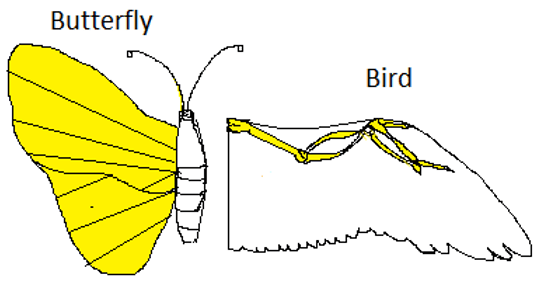This set of Class 12 Biology Chapter 7 Multiple Choice Questions & Answers (MCQs) focuses on “Evidences for Evolution”.
1. The industrial revolution phenomenon demonstrate _____
a) Gene mutation
b) Genetic drift
c) Natural selection
d) Migration
View Answer
Explanation: Due to industrial revolution, the color of the trees varies and the population of white and black moths also varies accordingly. Absence of industries enhanced the population of white moths and reduced the growth of black moths and vice versa. Hence, the species capable of surviving is selected by the nature.
2. In the ancestry line of Tyrannosaurus, which ancestor is present?
a) Crocodile
b) Triceratops
c) Archaeopteryx
d) Brachiosaurus
View Answer
Explanation: Tyrannosaurus belongs to the ancestry line of Brachiosaurus. Here, crocodile belongs to the ancestral line of Archaeopteryx, whereas Triceratops belongs to the ancestral line of Stegosaurus.
3. In some animals, the same structures develop along different directions due to adaptations to different needs, this is called as _____
a) Divergent evolution
b) Convergent evolution
c) Parallel evolution
d) Saltation
View Answer
Explanation: It is called divergent evolution and the structures are called homologous organs. Homology indicates that the animals have common ancestors. Vertebrate heart or brains is an example of homologous organs.
4. The given figure shows an example of _____

a) Analogous organs
b) Homologous organs
c) Vestigial organs
d) Divergent evolution
View Answer
Explanation: The wings of butterflies and birds do not possess similarity in structure but they perform the same function, which is flying. This type of organs is called analogous organs. They follow convergent evolution.
5. Which among the following are examples of homologous organs?
a) Wings of butterfly and bird
b) Flippers of penguins and dolphins
c) Eye of octopus and mammals
d) Forelimbs of whales, bats, cheetah and humans
View Answer
Explanation: Forelimbs of whales, bats, cheetah and humans are homologous organs. They all have similar structure but perform different functions. The remaining options are examples of analogous organs.
6. The fossils are evidences buried deep inside the soil; they can occur where _______
a) Animals are destroyed by natural disasters
b) Animals are buried and preserved by natural process
c) Animals are eaten by predators
d) Animals die themselves
View Answer
Explanation: Fossils are paleontological evidences or remains that are useful for finding the species living their millions of years ago. Fossils only occur where animals are buried and preserved by natural process. They mainly preserved in rocks.
7. Sweet potato and radish are examples of analogous organs.
a) True
b) False
View Answer
Explanation: Sweet potato and potato are examples of analogous organs, whereas sweet potato and radish are the wrong examples. Since both sweet potato and radish have the same structure i.e. root modification and function.
8. What is the scientific name of moth that demonstrated industrial melanism?
a) Biston betularia
b) Biston formalia
c) Biston mothis
d) Periplaneta americana
View Answer
Explanation: This moth was used as an example for Natural selection by Barnard. It showed that only the fittest and the one that can escape from predators will survive in nature, during the time of industrial revolution.
9. Which among the following are the characteristics of lichens?
a) They can survive in polluted areas
b) They can eat insects
c) They can indicate industrial pollution
d) They can self-pollinate
View Answer
Explanation: Lichens do not grow in polluted areas, and are used to indicate industrial pollution. They get destroyed in presence of Sulphur dioxide present in the polluted air. So, we can notice only green algae.
10. Dinosaurs are ________
a) Not extinct
b) Extinct
c) Becoming extinct
d) Myths
View Answer
Explanation: Dinosaurs are extinct. Their fossils were discovered in Mongolia mainly Velociraptor and Protoceratops. It shows that dinosaurs existed years ago and are now not alive. Scientist say that they were destroyed by meteorites.
11. Dinosaurs originated during the period _______
a) Triassic
b) Jurassic
c) Cretaceous
d) Cambrian
View Answer
Explanation: Around 3.5 crore years ago, the first dinosaurs, flying reptiles originated. It was during the period Triassic. Jurassic was the golden age of dinosaurs whereas cretaceous is the period in which the dinosaurs became extinct.
Sanfoundry Global Education & Learning Series – Biology – Class 12.
To practice all chapters and topics of class 12 Biology, here is complete set of 1000+ Multiple Choice Questions and Answers.
If you find a mistake in question / option / answer, kindly take a screenshot and email to [email protected]
- Practice Class 12 - Mathematics MCQs
- Check Class 12 - Biology Books
- Practice Class 12 - Chemistry MCQs
- Practice Class 12 - Physics MCQs
- Practice Class 11 - Biology MCQs
